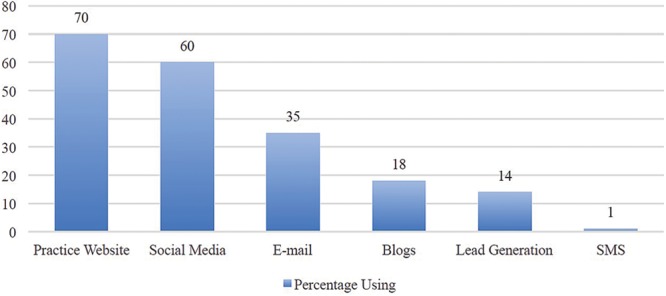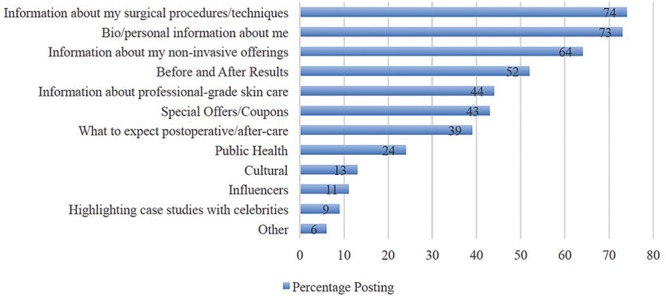Summary:
Social media is beginning to eclipse practice websites and other traditional electronic marketing utilized by plastic surgeons. First, highlights are presented from the relevant electronic marketing literature. Next, this article presents a new case study of how, why, when, and what social media is being used by ASPS members (n = 100). Results suggest a significant disconnect between plastic surgeons and the highest impact platforms reported in the literature such as Instagram, YouTube, Snapchat, and Facebook. Plastic surgeons currently prefer to focus electronic marketing efforts on practice websites over social media platforms. This study suggests that instead of relying on their practice websites to disseminate information, surgeons should be utilizing social media, posting promotions, before-and-after photos, and videos to develop their client base.
For practice building in plastic surgery, the days of relying on physician referrals, word of mouth, and academic pedigrees are gone. Google is the largest single referral source1 and third-party validation by consumers on websites like RealSelf has become more critical to patients’ trust than education or training.2 Plastic surgeons initially responded to this electronic shift by focusing on website content and search engine optimization. However, Google’s algorithms place plastic surgeons with more social media followers to the top pages3 and RealSelf reports a 17% drop in click-through traffic to practice websites since 2016.2 Now the spotlight is on social media. When building a new practice, there is a higher return of investment with Facebook and Instagram than search engine optimization and referral websites Yelp and RealSelf.4 Only 5 short years ago, social media was perceived as an inevitable force but having no impact on practice building by most ASPS members surveyed.5 Perhaps, those were established practices reliant on word of mouth and return of existing patients.4 The current case study provides an important update.
Today, 88% of 18–34 year olds engage with social media.6 Millennials are likely to post their plastic surgery experiences on social media—not much is off limits, and their growth in plastic surgery procedures has surpassed baby-boomers as of 2017.7 A 2018 crowdsourcing survey of 774 patients seeking plastic surgery (mean age 39.5) ranked Facebook and YouTube as the most important platforms, doctor as preferred messenger, and Live video as the favorite format.8 Another survey of 100 consecutive plastic surgery consults ages 18–70 (mean 44) found the highest engagement in Facebook, Instagram, and YouTube, and the least interest in Twitter.9 They found prospective patients are most interested in posts of contests to win a free treatment or product, before and after photographs, and information about the practice. Patients are also interested in real patient testimonials, treatment videos, doctor’s videos, and doctor’s blogs. Choosing the right platform is critical for effective engagement with prospective clients.
To better understand how the plastic surgery community engages with electronic marketing, including practice websites and social media in promoting their practices, young plastic surgeons were surveyed via Survey Monkey, with 100 responding from almost 40 different states. Three e-mail solicitations were sent to the 1,100 young plastic surgeons over 1 month, the study was capped at 100 (9%). Selection bias may exist; respondents were ASPS members age 42 and under, but they are the target audience for practice building. No incentive was offered. Most respondents were in office-based practices (64%), the majority (72%) performed both cosmetic and reconstructive surgeries, 16% cosmetic only, and 12% reconstructive only.
Participants were asked how they digitally market for their practice. The majority indicated they use a personal/practice website (70%) for marketing and/or social media platforms (60%), with e-mail, blogs, lead generation sites, and short message service (SMS) messaging selected less often (Fig. 1). Interestingly, participants also indicated that personal websites were the most important channels to them for online marketing, rating this method higher (4.51, P = 0.00) on a 5-point Likert scale than all other options.
Fig. 1.

ASPS young plastic surgeons were asked how they digitally market for their practice. The majority indicated they use a personal/practice website (70%) for marketing and/or social media platforms (60%), with e-mail, blogs, lead generation sites, and SMS messaging selected less often.
Of social media platforms, Instagram (29%) and Facebook (27%), were the platforms used by most participants. Only 5% selected YouTube, IGTV, and Twitter and none mentioned Snapchat.
Also addressed was why participants electronically market. Attracting new patients and promoting their practice and services were most important, with keeping patients connected to the practice and highlighting accomplishments also noted.
Questions were asked about what the content was for online marketing with “information about my surgical procedures and techniques” and “bio/personal information about me” being the top types of content (73%–74% of respondents). More than half of respondents indicated they market information about noninvasive offerings, practice branding, information about injectables, and before-and-after photos (Fig. 2).
Fig. 2.

ASPS Young Plastic Surgeons were asked what the content was for online marketing with “information about my surgical procedures and techniques” and “bio/personal information about me” being the top types of content (73%–74% of respondents). More than half of respondents also marketed information about noninvasive offerings, practice branding, information about injectables, and before-and-after photographs.
When asked about when or how often they post to social media, the participants(n = 54) posted several times a week (37%), every couple of weeks (24%), daily (16%), multiple times per day (11%), or very little (11% once a month or every 6 months) (Fig. 3).
Fig. 3.

ASPS young plastic surgeons were asked how often they posted (n = 54) and majority posted several times a week (20) to every couple of weeks (13).
As might be expected those who did not engage with social media regularly, rated their practice websites more important than other channels.
There may be a disconnect between how prospective patients seek information and plastic surgery practices’ marketing efforts. Most plastic surgeons view their websites as the most important way to communicate with patients. While only 15% of plastic surgeons post on social media daily, 71% of Millennials engage multiple times a day on Snapchat and Instagram and nearly 68% of adults engage daily on Facebook.5 Social media has become a primary means of exploring online, and aesthetic patients include social media in their decision-making.10 Potential patients now equate presence and activity on social media with depth of experience and competence. Moving forward, plastic surgeons need to recalibrate their efforts to engage with social media in addition to their websites. To post, or not to post, that is no longer the question.
Footnotes
Published online 25 July 2019.
Disclosure: Ben Newcott is an Allergan employee. This research stemmed from an Essential of Leadership project in which he was invited by American Society of Plastic Surgeons (ASPS) to participate. The other authors have no financial interest to declare in relation to the content of this article.
REFERENCES
- 1.Walden JL. Commentary on: patients’ and surgeons’ perceptions of social media’s role in the decision making for primary aesthetic breast augmentation. Aesthet Surg J. 2018;38:1088–1091. [DOI] [PubMed] [Google Scholar]
- 2.Low R. Competitive Advantage in an UBER-Competitive Market Sciton User Summit Tysons Corner; Nov. 2018, verbal presentation.
- 3.Gould DJ. Commentary on: are you on the right platform? A conjoint analysis of social media preferences in aesthetic surgery patients. Aesthet Surg J. epub; DOI: 10.1093/asj/sjy269 [DOI] [PubMed] [Google Scholar]
- 4.Gould DJ, Nazarian S. Social media return on investment: how much is it worth to my practice? Aesthet Surg J. 2018;38:565–574. [DOI] [PubMed] [Google Scholar]
- 5.Vardanian AJ, Kusnezov N, Im DD, et al. Social media use and impact on plastic surgery practice. Plast Reconstr Surg. 2013;131:1184–1193. [DOI] [PubMed] [Google Scholar]
- 6.Pew Research Center. Social Media Use in 2018; 2018. Available at http://www.pewinternet.org/2018/03/01/social-media-use-in-2018/. date accessed: Nov 17, 2018
- 7.The American Society for Aesthetic Plastic Surgery. Cosmetic surgery national data bank statistics. Aesthet Surg J. 2017;37(suppl_2):1–29. [DOI] [PubMed] [Google Scholar]
- 8.Nayyar A, Jadi J, Garmella R, et al. Are you on the right platform? A conjoint analysis of social media preferences in aesthetic surgery patients. Aesthet Surg J. 2018. epub; DOI: 10.1093/asj/sjy238 [DOI] [PubMed] [Google Scholar]
- 9.Sorice SC, Li AY, Gilstrap J. Social media and the plastic surgery patient. Plast Reconstr Surg. 2017;140:1047–1056. [DOI] [PubMed] [Google Scholar]
- 10.Montemurro P, Cheema M, Hedén P. Patients’ and surgeons’ perceptions of social media’s role in the decision making for primary aesthetic breast augmentation. Aesthet Surg J. 2018;38:1078–1084. [DOI] [PubMed] [Google Scholar]


